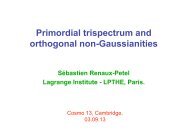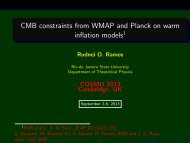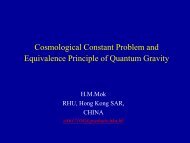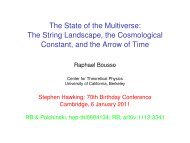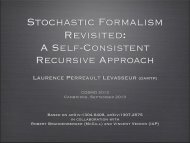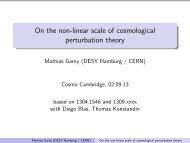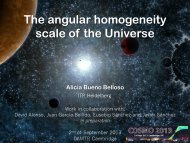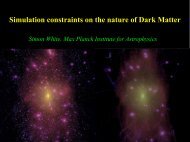Dispersion of the luminosity distance as a cosmological probe
Dispersion of the luminosity distance as a cosmological probe
Dispersion of the luminosity distance as a cosmological probe
Create successful ePaper yourself
Turn your PDF publications into a flip-book with our unique Google optimized e-Paper software.
<strong>Dispersion</strong> <strong>of</strong> <strong>the</strong> <strong>luminosity</strong> <br />
<strong>distance</strong> <strong>as</strong> a <strong>cosmological</strong> <strong>probe</strong> <br />
Ido Ben-‐Dayan <br />
DESY <br />
Cambridge, Cosmo 2013 <br />
Collaborators: Maurizio G<strong>as</strong>perini, Tigran <br />
Kalaydzhyan, Giovanni Marozzi, Fabien Nugier, <br />
Gabriele Veneziano.
Outline <br />
! Current status <strong>of</strong> power spectrum me<strong>as</strong>urements <br />
! New <strong>probe</strong>: Lensing <strong>of</strong> Supernovae Type Ia <br />
1. Average and dispersion <strong>of</strong> <strong>the</strong> <strong>luminosity</strong> redshift <br />
relation <br />
2. Lensing dispersion (Hui & Green, Dodelson et al., <br />
Amendola et al., Jonsson et al., Kronborg et al., March et <br />
al.) <br />
3. Constraints from current data.
Primordial Power <br />
Spectrum
Planck Me<strong>as</strong>urements <br />
! Even with PLANCK, Ly-‐alpha, etc. only <strong>probe</strong> ~8.5 e-folds<br />
out <strong>of</strong> 60. <br />
! Few observables, huge degeneracy between <br />
models. <br />
P prim. (k) =A s<br />
✓ k<br />
k 0<br />
◆ ns (k 0 ) 1+1/2↵(k 0 )ln(k/k 0 )+1/6 (k 0 )(ln(k/k 0 )) 2<br />
The power spectrum is <strong>the</strong> actual obsevrable and we <br />
need to me<strong>as</strong>ure it for <strong>as</strong> many e-‐folds possible!
Example: “string vs. <br />
field <strong>the</strong>ory” <br />
1.0<br />
0.9<br />
PLANCK<br />
PIXIE<br />
n s<br />
0.8<br />
0.7<br />
0.6<br />
0.5<br />
Accidental<br />
n⩵3<br />
n⩵4<br />
n⩵6<br />
n⩵10<br />
0 10 20 30 40 50<br />
N<br />
V ( )=⇤ 4 (1 a 1 a n n )<br />
1309.xxxx, IBD, S. Jing <br />
C. Wieck and A. Westphal
Spectral Distortions <br />
! We can me<strong>as</strong>ure deviations <strong>of</strong> <strong>the</strong> CMB from a black <br />
body spectrum – MODEL INDEPENDENT <br />
⇒ Can be used to constrain <strong>the</strong> primordial power <br />
spectrum for ! (1
Current and Future
d L -‐z relation <br />
• Gauge inv. Light-‐cone avg. procedure. 2 nd <br />
order pert. <strong>the</strong>ory, NO DIVERGENCES! <br />
• kUV=30h Mpc -‐1 , WMAP data. <br />
sm<br />
0.14<br />
0.12<br />
0.10<br />
0.08<br />
0.06<br />
0.04<br />
PLANCK DATA <br />
• Flux is minimally bi<strong>as</strong>ed. <br />
• The dispersion is large ~ 2-‐10% ΛCDM, <strong>of</strong> <strong>the</strong> <br />
critical density depending on <strong>the</strong> spectrum. <br />
Scatter is mostly from <strong>the</strong> LC average. It <br />
gives <strong>the</strong>oretical explanation to part <strong>of</strong> <strong>the</strong> <br />
scatter <strong>of</strong> SN me<strong>as</strong>urements. At z>0.3 <br />
dominated by lensing. <br />
IBD, M. G<strong>as</strong>perini, G. Marozzi, F. Nugier, G. <br />
Veneziano <br />
m-m M<br />
0.02<br />
0.00<br />
0.3<br />
0.2<br />
0.1<br />
0.0<br />
-0.1<br />
-0.2<br />
0.6 0.8 1.0 1.2 1.4 1.6<br />
PLANCK DATA <br />
z<br />
0.02 0.05 0.10 0.20 0.50 1.00 2.00<br />
z
Lensing <strong>Dispersion</strong> <strong>of</strong> <br />
SNIa <br />
! Current data h<strong>as</strong> SN up to z~1.3 <br />
total<br />
µ (z apple 1) < 0.12<br />
! Model dependent-‐ LCDM and HaloFit model. (Smith <br />
et al. 2003, Takah<strong>as</strong>hi et al. 1,2 2012) <br />
! An overall upper bound on dispersion. Any <br />
enhancement <strong>of</strong> <strong>the</strong> power spectrum will incre<strong>as</strong>e <br />
<strong>the</strong> dispersion. WHAT’S THE CORRECT SPECTRUM <br />
s Z dk<br />
µ(z) ' 0.7<br />
˜ ⌘(z) =<br />
Z z<br />
0<br />
✓ ◆ 3 k<br />
k P (k, z) ˜ ⌘(z)<br />
3<br />
H 0<br />
dy<br />
p<br />
⌦m0 (1 + y) 3 +⌦ ⇤0<br />
µ(z = 1) ' 0.47s Z<br />
dkk 2 P (k, 1) ⌘ 0.47 p T 2 (P )
200<br />
100<br />
50<br />
Power spectrum <br />
! HaloFit cannot be trusted for large running or <br />
running <strong>of</strong> running. <br />
! Treat F(k,z)=P NL /P L <strong>as</strong> a transfer function, at z=1. <br />
! 2 methods: 1) step function 2) interpolated function. <br />
Both extremely underestimating. <br />
! kUV=320h. kUV=30h degrades results but still cuts out <br />
parameter space allowed by PLANCK. <br />
P prim. (k) =A s<br />
✓ k<br />
k 0<br />
◆ ns (k 0 ) 1+1/2↵(k 0 )ln(k/k 0 )+1/6 (k 0 )(ln(k/k 0 )) 2<br />
20<br />
10<br />
5<br />
2<br />
1<br />
0.01 0.1 1 10 100<br />
T 2 (P )=<br />
T 2 (P )=<br />
Z kUV<br />
H 0<br />
dkk 2 P L (1 + bH(k k NL ))<br />
Z kUV<br />
H 0<br />
dkk 2 P L (k)(1 b + bH(k k NL )F (k, z))
1-‐b+b F(k,z) 1309.xxxx <br />
Region <strong>of</strong> constraints Hs m > 0.12L
1+b H(k-‐k NL ) 1309.xxxx <br />
Region <strong>of</strong> constraints Hs m > 0.12L
Summary <br />
! Demonstrated <strong>the</strong> shortcomings <strong>of</strong> current inflationary <strong>probe</strong>s. <br />
! Calculation <strong>of</strong> <strong>the</strong> d L -‐z relation, average and dispersion, useful for parameter <br />
estimation. <br />
! 2 New and extremely competitive <strong>probe</strong>s: <br />
1. Spectral Distortions – Model independent, current A
From Interpolation <br />
0.08<br />
Region <strong>of</strong> constraints Hs m > 0.12L<br />
0.06<br />
Running <strong>of</strong> Running d 2 nsêdlnk 2<br />
0.04<br />
0.02<br />
0.00<br />
-0.02<br />
-0.04<br />
-0.06 -0.04 -0.02 0.00 0.02 0.04 0.06<br />
Running dn s êdlnk
From Step <br />
0.08<br />
Region <strong>of</strong> constraints Hs m > 0.12L<br />
0.06<br />
Running <strong>of</strong> Running d 2 nsêdlnk 2<br />
0.04<br />
0.02<br />
0.00<br />
-0.02<br />
-0.04<br />
-0.06 -0.04 -0.02 0.00 0.02 0.04 0.06<br />
Running dn s êdlnk
Closer Look at <strong>the</strong> <br />
Lensing Integrand
LC Averaging <br />
! Useful for interpreting light-‐like <br />
signals in <strong>cosmological</strong> <br />
observations. <br />
! Hyper-‐surfaces using meaningful <br />
physical quantities: Redshift, <br />
temperature etc. <br />
! Observations are made on <strong>the</strong> <br />
light-‐cone. Volume averaging <br />
give artefacts and <strong>the</strong> matching <br />
with data is not clear. <br />
! P<strong>as</strong>t attempts: Coley 0905.2442; <br />
R<strong>as</strong>anen 1107.1176, 0912.3370
Light Cone Averaging <br />
1104.1167 <br />
! A-‐priori -‐ <strong>the</strong> averaging is a geometric procedure, does not <br />
<strong>as</strong>sume a specific energy momentum tensor. <br />
The prescription is gauge inv., {field reparam. A-‐>A’(A), V-‐<br />
>V’(V)} and invariant under general coordinate <br />
transformation. A(x) is a time-‐like scalar, V(x) is null. <br />
This gives a procedure for general space-‐times.
Prescription Properties <br />
! Dynamical properties: Generalization <strong>of</strong> Buchert-‐Ehlers <br />
commutation rule: <br />
! For actual physical calculations, use EFE/ energy momentum tensor <br />
for evaluation. Example: which gravitational potential to use in <br />
evaluating <strong>the</strong> dL-‐z relation. <br />
! Averages <strong>of</strong> different functions give different outcome <br />
F(S) ≠ F S
GLC Metric and Averages <br />
! Ideal Observational Cosmology – Ellis et al. <br />
! Evaluating scalars at a constant redshift for a geodetic observer. <br />
~<br />
I(<br />
S,<br />
w = ∫<br />
I(<br />
S,<br />
w0<br />
, z)<br />
S = ;<br />
I(1,<br />
w , z)<br />
1+<br />
z =<br />
2<br />
a<br />
a<br />
0,<br />
z)<br />
d θ γ ( w0<br />
, z,<br />
θ ) S(<br />
w0<br />
, z,<br />
θ<br />
Υ<br />
Υ<br />
O<br />
S<br />
0<br />
~<br />
~<br />
);
Exact Result -‐ Flux <br />
LC average <strong>of</strong> flux for any space-‐time amounts to <strong>the</strong> <br />
area <strong>of</strong> <strong>the</strong> 2-‐sphere! (JM subleading correction drops <br />
out) <br />
Φ =<br />
L<br />
4πd ; d (z) = (1+ 2 L z)2 d S<br />
; d 2 S<br />
≡ dS =<br />
L<br />
dΩ O<br />
γ<br />
sin θ<br />
γ = ρ 2 sinθ<br />
d s<br />
≡ ρ =<br />
∑<br />
l,m<br />
a lm<br />
(w 0<br />
, z s<br />
)Y lm<br />
(θ,ϕ)<br />
∫ d 2 θ γ = ∫ d 2 θρ 2 sinθ = ∑ a lm<br />
(w 0<br />
, z s<br />
) 2<br />
> a 2 00<br />
Anisotropies always “mimic” acceleration! <br />
l,m



